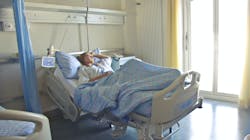COVID-19 symptoms can persist for months after hospital stays
Most patients requiring hospitalization for COVID-19 had symptoms—particularly fatigue and shortness of breath—for a mean of 111 days after returning home, according to a research letter published in the Journal of Infection, states a report from the Center for Infectious Disease Research and Policy (CIDRAP).
Researchers administered a phone questionnaire to 120 COVID-19 patients hospitalized from March 15 to April 14 at University of Paris–affiliated Beaujon Hospital. Ninety-six patients had been treated in the general ward, while 24 required intensive care unit (ICU) care with artificial ventilation.
The most common persistent symptoms were fatigue (55 percent), shortness of breath (42 percent), memory loss (34 percent), lack of concentration (27 percent), and sleep disorders (31 percent). Twenty-four patients (20 percent) reported hair loss, 20 of whom were women. There was no statistically significant difference in symptoms between ward and ICU patients.
In both groups, slightly more ICU patients reported continued pain on health-related quality-of-life (HRQoL) self-assessment EQ-5D-5L subtests, but there were no other differences. Mean EQ-5D score was 0.86, indicating relatively good QoL.
Mean score on the EQ-VAS was 70.3 percent, indicating good health. "This clearly supports the interest of a full resuscitation for COVID patients despite heaviness of cares," the authors wrote.
Thirty-five patients (29 percent) had a Modified Medical Research Council Dyspnea Scale grade of 2 or higher, indicating that they walked slower than their peers because of shortness of breath or had to stop to catch their breath when walking at their own pace.
Before participants were infected by the coronavirus, 47 percent held jobs. Of them, 69percent had returned to work by the time they were interviewed. The difference between percentages of ward and ICU patients who resumed work was not statistically significant.
Of the 39 patients who participants in sports before their hospitalizations, 72 percent had resumed physical activity, but 46 percent said they exercised less vigorously.
Median participant age was 63 years, 62.5 percent were men, 46.7 percent had high blood pressure, and 21.7 percent had diabetes. Symptoms at hospital admission included shortness of breath (73.3 percent), cough (72.5 percent), diarrhea (24.2 percent), muscle pain (15.8 percent), and confusion (5.8 percent). Median length of hospitalization was 11 days.
The researchers said they were surprised by the high percentage of patients—especially women—who reported substantial hair loss, which they indicated may be caused by telogen effluvium, a type of temporary hair loss triggered by stress, shock, trauma or viral infection, and/or the stress of being ill and hospitalized.
But overall, HRQoL was satisfactory, and most who had a job before their illness returned to work. "While there were few differences between HRQoL between ward and ICU patients, our findings must be confirmed in larger cohorts, including more severe ICU patients," the authors concluded.
